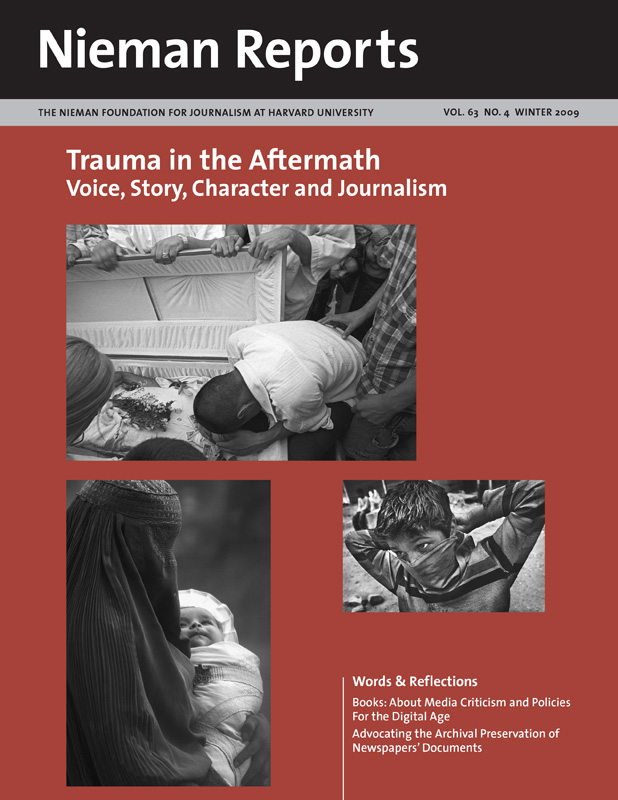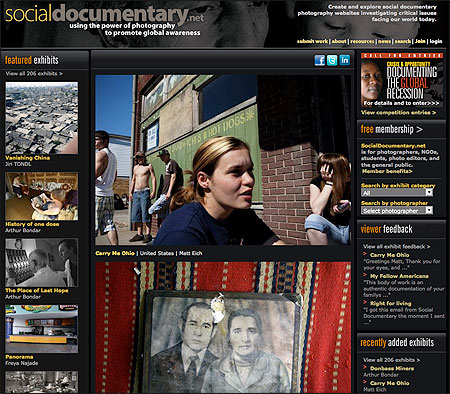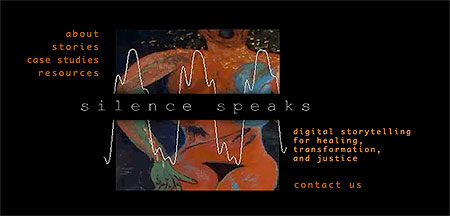Brian Storm is the president of MediaStorm, which produces multimedia narratives that combine audio, video, still photography, and animation to tell stories of the human condition. They include “Intended Consequences” about Rwandan women who became pregnant through rape during the 1994 genocide, “Finding the Way Home: Two Years After Katrina,” and “Never Coming Home.” In his presentation at the “Aftermath” conference, Storm talked about the emotional process of producing “Intended Consequences.” What follows are edited excerpts from Storm’s presentation:
“Intended Consequences,” a project done by photojournalist Jonathan Torgovnik, is basically the story of the Tutsi women who were raped by Hutus and how they’re struggling with the legacy of genocide now that they have 12- and 13-year-old kids as a result. This is a pretty complex project for a variety of reasons. It was traumatic for us to bring the multimedia story together; I think I probably listened to each of these women’s stories 20 or 30 times, and there are 26 women with whom we worked on the piece. We worked on the Rwanda piece for a year. It was a really hard production for us. We had to take time off; we had translation issues and we had to take big periods of time off because we were pretty torn up by it as well.
Storm showed the video in which three Rwandan women describe their lives:
After the genocide I have many children that I look after. My brothers and sisters were all killed, but they had children who had survived. So I have seven children that I look after. My children, my orphans, my daughter are my hope. They know I’m their everything. I’m their uncle. I’m their auntie. I’m their mother. I’m their father. I’m their grandmother. I am everything for them. So they don’t want to hear that I am HIV positive. But that’s the reality they have to live with. I am. I live with HIV, which is a legacy of genocide.
I am a mother but unwilling to be a mother. Whenever I look at this child I trigger back to the memories of rape. Maybe with time I will love this daughter of mine. Maybe. But for now, no.
I love the first daughter more because I gave birth to her as a result of love. Her father was my husband. The second girl is a result of an unwanted circumstance. I never loved this kid.
Storm describes how he spreads word about his projects through his Web site. Go to www.mediastorm.org and follow along as Storm walks through the site’s interactive features. To learn more about how MediaStorm, his for-profit company, functions, explore Storm’s background, and understand his approach to producing these multimedia narratives, read an interview with him in the Spring 2009 issue of Nieman Reports.
RELATED ARTICLE:
“Long-Form Multimedia Journalism: Quality is the Key Ingredient,” an interview with Brian Storm from the Spring 2009 Nieman Reports.We do a lot of things to create awareness. We use med; we’ll do this as a trailer that allows the viewer to then click through to our site. That drives a lot of traffic and exposure. We’re really focused right now on the social network opportunity. We’re on MySpace because a ton of people will watch a project there. And Ning, which has very little traffic right now, I think will eventually blow up. And the granddaddy, Facebook, which went from nothing five months ago for us to the number seven driver of traffic to our Web site. I use Facebook pretty intensively.
The tools are so powerful now that, as journalists, we can take journalism back—to not be answering to shareholders but to be focused on doing the kind of journalism we want to do and then partnering with other organizations to get the word out. The opportunity now is really big for independent producers to create compelling content and transact with larger organizations. And we do interactive applications. When I look at the future for a media company this is an important element: being able to do interactive applications that help make information more accessible.
I’ve long ago crossed that line of being an objective journalist. I’m an advocacy journalist. I make no bones about it. I describe our organization as a purpose-driven organization, not a profit-driven organization. We’ll do a job for Starbucks because it pays for Rwanda. The beauty is I never took venture capital money. We’re totally break even, making a little money every month and then we’re just plowing it back in. I don’t have to go home and talk to my investors and say, “Dude, I’m not close to that 30 percent margin.” I’m focused on building what I want to build and practicing journalism the way I always wanted to practice it.
The thing that’s so important about our model is that we don’t do volume. We don’t do perishable content. Every story on our site still matters, it’s still valuable. In fact, stories that we did three years ago are getting watched more today than they were then. We do the universal story that will stand the test of time. That’s what we’re looking for. I think that can work. That’s a patience model.

Editor’s note: The print edition of Nieman Reports incorrectly identifies Barbara Ayotte as the former director of Physicians for Human Rights. She was the organization’s communications director.Glenn Ruga and Barbara Ayotte are the founders of SocialDocumentary.net, a Web site featuring documentary photography from around the world. Ruga is a full-time graphic designer, part-time social documentarian, and a lifelong human rights activist. He is the owner and creator of Visual Communications and the founder and president of the Center for Balkan Development, a nonprofit organization created in 1993 to help stop the genocide in Bosnia and to create a just and stable future for the former Yugoslavia. Ayotte is a communications strategist and human rights activist. For 17 years she was director of communications for Physicians for Human Rights where she paired storytelling with advocacy on behalf of torture, rape and land mine survivors, refugees and asylum seekers. Edited excerpts from their remarks follow:
Ruga: Human rights photography is actionable as opposed to representational. In other words, the power of the work is really to make change. It’s not strictly to represent something out there in the world, but the act of presenting this work and looking at this work itself can make change. It sparks public discourse, it can spur reform, and it can shift the way we think about these situations in the world and ourselves.
In the world of human rights there are perpetrators and survivors, and there are journalists who inform us about these violations, researchers who give us data and analysis, and advocates who work for policy change to prevent violations and support the victims. Artists, filmmakers, photographers and writers document and help us understand the abusers and the abused. Then, there are lawyers, judges and lawmakers who provide the legal context. Of these groups, photographers can document the abuses, honor the victims, and tell their stories of abuse, survival and justice.
Our goal is to use the power of photography to humanize these global situations. Unlike traditional journalism, we at SocialDocumentary.net encourage a point of view. Exhibits are not necessarily objective, yet each exhibit must demonstrate infinite respect for the subject even when a photographer approaches the subject with disdain or superiority. The work must be fundamentally about the subject, not about the photographer. This is a very un-modernist approach to image-making. So much of modern image-making is about the image maker. What we’re interested in is work that really is about the subject.
Photographers must be willing to invest time. It’s not adequate to just go into a situation and spend one day photographing. Most who do this work well go back repeatedly over the course of months or years to tell these stories.
Ayotte: Our content on SocialDocumentary.net is user-generated; we don’t edit the work nor do we solicit it. It’s a collaborative approach to trying to understand the human condition. We try to encourage links to be made to nongovernmental organizations and other people who do work related to the issues raised by the photographs so that viewers who come and look at the work can do something about it if they feel moved to do so.

As the special projects director for the Center for Digital Storytelling in Berkeley, California, Amy Hill manages Silence Speaks and other national and international projects related to youth development, public health, and human rights. Silence Speaks is a decade-old digital storytelling initiative that blends oral history, participatory media making, and popular education and workshops to support the telling of stories that often remain untold. In the edited excerpts below, Hill describes what distinguishes digital storytelling from other media:
People use the term “digital storytelling” in a lot of different ways to refer both to production practices or processes as well as to media products. I would like to comment on what distinguishes it for me from other ways to make media. Also, all of the work that I do is explicitly tied to trying to effect policy change. That is different from journalism. I don’t claim to be a journalist.
The digital storytelling I do privileges the first-person narrative voice that is somewhat absent from more traditional daily journalism. It also relies on a group process in which mutual telling and listening provide a safe container and contribute to the shaping of the narratives. It’s not an individual practice in which one journalist or filmmaker or artist works one on one with someone. There is a commitment to participatory production methods; storytellers don’t passively give their stories but they have a direct hand in making their stories into short media pieces. The extent to which they can do so varies by location. It’s intended to be purposeful, whether at an individual level alone as healing or as practice in building and transmitting skills or at a wider level in terms of its potential impact on viewers.
With computer tutorials we assist people in learning what they need to know about editing to put together their own stories. In rural Uganda and South Africa, we have provided people with disposable cameras and talked with them about how to use them. We’ve done a lot of work blending photo and voice strategies with digital storytelling. This might also happen through tactile art making, such as illustrating with drawings. There are a lot of different options depending on the context.
Those who participate in this process are very carefully screened to make sure that they have adequate internal readiness as well as external support for sharing their stories. I very, very strongly emphasize that this is not a process for somebody who is experiencing symptoms of post-traumatic stress disorder. It’s a much more reflective practice. It tends to work better when people are sharing stories that span a slightly longer time frame and addressing more historic issues. In working with survivors of trauma, it can be useful to think of trauma as a spiral; if you’re working with somebody who’s been through a traumatic experience, your role is to facilitate them in a journey into that spiral but also to make sure that you spiral them back out. Otherwise, you can do a lot more damage and re-traumatize.
I’m a trained sexual assault counselor, not a licensed therapist. But I have a lot of background in working with survivors. And I’ve worked with a good friend of mine who’s a social worker who specializes in trauma issues. We have a whole set of screening materials and readiness questions that we work on with people to help assess whether they’re prepared.





